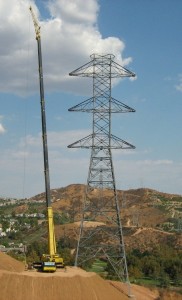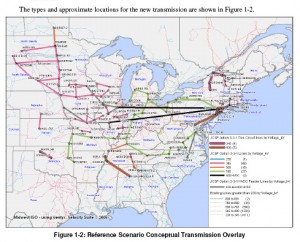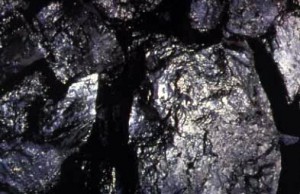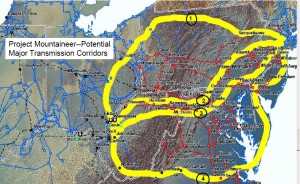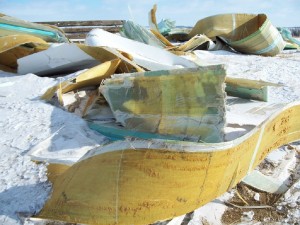Getting railroaded?
February 2nd, 2010
We all know what a pain in the patoot siting transmission is (particularly when it’s not needed). And now for something completely different — an interesting and seemingly probable theory:
ARE Y’ALL PAYIN’ ATTENTION??!!!?!?!?!
This is one of those pieces that I want to preserve to take out and reread in the not too distant future:
Buffett’s Semaphore Signal: Should Burlington Northern Shareholders Think Again Before Saying ‘Yes’ To Berkshire Hathaway?
Author: Daniel Sinclair
Reasons commentators ascribe to Buffett’s offer to acquire one of North America’s largestrail networks, Burlington Northern Santa Fe (BNSF) are now familiar. Growing global trade, continued reliance on (especially low sulphur) coal, a resurgent and growing US economy (without needing to pick product ‘winners’ and ‘losers’), a low risk way to gain exposure to any rising process for commodities, a hedge against inflation given rail’s pricing power, a competitive advantage in rail’s oligopoly and high barriers to entry, more productive rail with more efficient and technologically advanced operations and a rise double-decker railway carriages, a way to play higher oil prices and cap and trade or carbon tax laws given that rail is 3 to 4 times more fuel efficient than trucks.
Those reasons are all good, and they have been part of the core investment thesis for rail. But, it is submitted, there may be something extra that offers compelling upside to rail that has Buffett excited. Think about all the land that rail owns. BNSF, for example, operates one of the largest railroad networks in North America with about 32,000 route miles of track plus an additional 23,000 miles for other rail related infrastructure and property. Much of this land is of relatively little value beyond the use of rail. No one is going to build condos or hotels or new subdivisions along side railways.
Now think again. You think Boone Pickens has an ambitious plan for wind farms? Wait until you see what Buffett could do right across the US with his investment in BNSF. This land might become prime property for alternative energy generation including from wind and solar farms either side of rail tracks. With much of rail land in the middle of nowhere, there are few worries about the ‘not-in-my-back-yard’ crowd and more difficult regulatory approvals. Small wind mills and solar panels might be placed on the trains themselves to generate energy.
Live from the PUC!
February 1st, 2010
Except that now there’s a delayed start, we’re missing a Commissioner…
Here’s some notes, we’re taking a break — I’m missing some parts, but here we go:
OK, the “ROUGH notes” are their in toto, but hey, I’ve got something better:
HERE’S THE MEETING – February 1 Agenda Meeting
You may have to download “Silverlight” to view the meeting.
PUC’s Health Impacts of Wind Turbine Docket
January 26th, 2010
9:30 a.m. on February 1, 2010
Minnesota Public Utilities Commission
Large Hearing Room
121 – 7th Place E., 3rd Floor
St. Paul, MN 55101
Remember the PUC’s docket that they opened after release of:
Apparently they’re looking at doing something — and here’s what the staff Briefing Papers say:
Here’s how staff defines the issue before the PUC:
Should the Commission find that current permit conditions regarding setbacks remain appropriate and reasonable in light of recent concern and the Minnesota Department of Health’s White Paper, Public Health Impacts of Wind Turbines?
And here’s the bottom line, what staff thinks should happen:
Staff recommends that the best approach to mitigate the issues discussed above would be comprised of two modifications to our current process.
1) Increase setbacks from non-participating landowner residences
a. Continue to use the existing 500-foot or noise standard residential setback (whichever is greater) to allow participating landowners to maximum their land use.
b. Increase the setback required from non-participating landowner residences to 1,000 feet or the state noise standard (whichever is greater) or some other number deemed appropriate by the Commission.
2) Require additional information from developers during the siting process to provide accurate and specific information to the Commission on the impacts of the project. Staff will continue to work on refining the specifics of these requests, additional information is anticipated to be (at a minimum, but could be subject to change):
a. During the application process:
I. noise modeling report (at different frequencies and at various distances from the turbines at various wind directions and speeds) throughout the project area;
II. if flicker is to occur on non-participating residences, shadow flicker modeling report, indicating anticipated maximum;
b. Preconstruction (submitted at time of final site layout):
I. final noise modeling report of final layout and noise monitoring proposal (both at different frequencies and at various distances from the turbines at various wind directions and speeds) throughout the project area;
II. final shadow flicker modeling report;
c. Post construction:
I. noise monitoring reports of the development (at different frequencies and at various distances from the turbines at various wind directions and speeds) throughout the project area.
To check out the whole docket and look at the various comments, CLICK HERE FOR PUC SEARCH PAGE , then scroll down a bit to the “Search” button and below that enter 09-845 and then click “Search.” Voila, there it all is!
So, be there or be square.
9:30 a.m. on February 1, 2010
Minnesota Public Utilities Commission
Large Hearing Room
121 – 7th Place E., 3rd Floor
St. Paul, MN 55101
Offshore transmission, NOT transmission from Midwest
December 6th, 2009
By standing up for offshore transmission for wind, Delaware’s Gov. Jack Markell stands up to Midwest coal!
The Mid-Atlantic states have been standing up and opposing transmission from the Midwest. They’ve gone on record in a number of venues, and in their opposition are citing Midwest transmission promoters’ disregard for eastern renewable efforts, that xmsn may well not be an economical way to get power to the east, and that THEY KNOW THAT MIDWEST TRANSMISSION PLANS INHERENTLY ARE ABOUT COAL. The plan they’re referring to is a massive transmission buildout known as JCSP, and it also applies to the big PJM buildout that includes the PA-NJ Susquehanna-Roseland transmission line that was the subject of a hearing last month.
Here’s JCSP (Joint Coordinated System Plan) note their site now talks about wind — but look where the transmission starts, DUH! The coal fields of the Dakotas:
Gotta give them, Delaware, Maryland and Virginia, a lot of credit for recognizing and stating what Midwest states have been unwilling to admit.
That said, here’s what Mid-Atlantic states are doing — they’re banding together to propose offshore transmission. If it’s underwater offshore transmission, that’s an idea that’s hard not to like. But I’ll bet it throws PJM for a loop, what with all their “backbone” transmission schemes, a la Project Mountaineer, that are in the works:
The FERC birth of Project Mountaineer:
And you can see that those lines in play now, PJM’s “backbone” transmission projects like Susquehanna-Roseland (NE part of Project Mountaineer Line 1) and MAPP (NE part of Project Mountaineer Line 4) are part of the plan… the big transmission plan that does not work for the east coast.
Here’s the Memorandum of Understanding between Delaware, Maryland and Virginia:
And recently, Gov. Jack Markell addressed these issues before American Wind Energy Association’s offshore windfest — but given the PJM big-transmission-projects-from-hell are referred to as “backbone” projects, I wish they’d find another term:
Delaware energy: ‘Backbone’ power line pushed for wind farms
By AARON NATHANS
The News JournalGov. Jack Markell broached the subject this week in his address to the American Wind Energy Association’s offshore wind workshop, the industry event of the year on this side of the Atlantic. Markell signed onto letters the governors sent to members of Congress this summer, and the Federal Energy Regulatory Commission last month.
“Let’s have the conversation,” O’Mara said. “It’s extremely worthy of further study.”
“It obviously won’t happen in the absence of federal leadership,” he said.
Fishermen’s Energy President Daniel Cohen said it’s a good idea, but “it’s another moving part.”
The benefits of building lines transmitting wind power from the Midwest are less certain, he said.
“It will be difficult to get progress in this area until there are clear national goals,” he said.
Note that “cost allocation” is raised. Since the 7th Circuit decision tossing out FERC approval of PJM’s transmission cost allocation dream/nightmare, all transmission projects 500kV and over based on that cost allocation scheme are in limbo.
So as noted, who pays, and submarine transmission is EXPENSIVE, is THE big issue now. It’s the big issue for land transmission, it’s the big issue for offshore transmission, and, given the uncertainty since the 7th Circuit decision, maybe some of the sturm and drang could be circumvented if it’s designed at 345kV or below, and uses the “benefactor pays” theory. We shall see…
Wind Investigation Comments In, Replies Due
September 23rd, 2009
Failed Suzlon turbine scattered on Minnesota snow
The PUC’s Wind Investigation looking at the MN Dept of Health – Public Health Impacts of Wind Turbines report and setbacks is moving forward. Here’s the report that apparently got them thinking:
The initial Comments are in. To see them:
- Go to www.puc.state.mn.us
- Click on eDockets
- Search for Docket 09-845
Reply Comments are due October 13th, and you’ll find reminders here!
